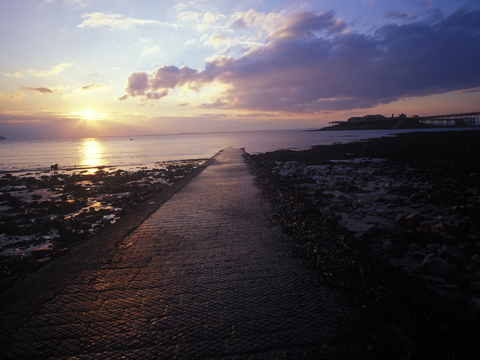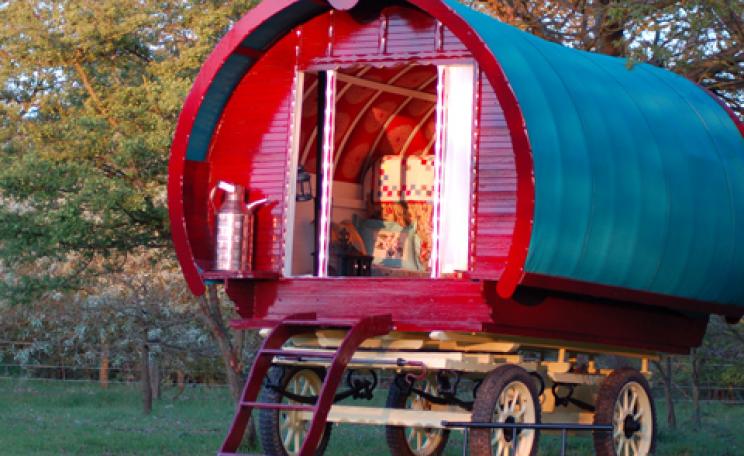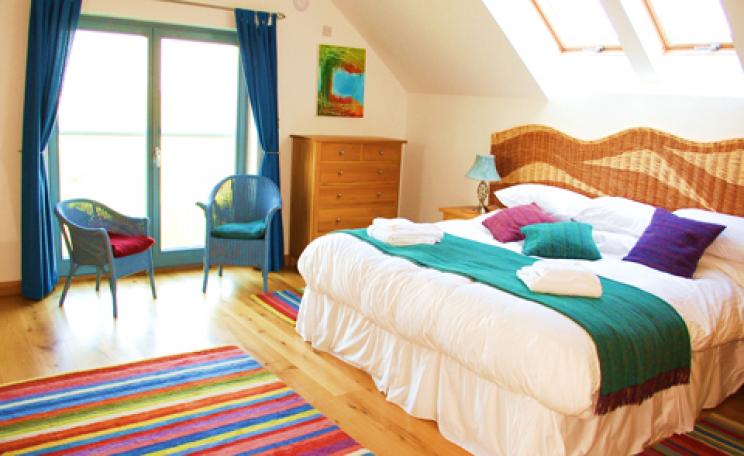Swirls of slippery seaweed jive under a pool of water. Others cling perilously to the rock face. I’d never studied seaweed before, but now standing among it, it is immensely beautiful. Some trail like wild hair, others are feathered or frilly, and they are all violently different shades of green, red, and brown. I am clambering around in rock pools, collecting seaweeds along a milk white sand beach on St Martins, one of the Scilly Isles; a sub-tropical archipelago, just 30 miles from Cornwall – so near and yet a world apart. Here the waters are a clear Caribbean turquoise and the pace of life mellows the second you arrive. But I'm not here for beaches. Instead I've come to look for wild foods with Rachel Lambert, a wild food expert; who leads foraging walks throughout England’s south west.
Hell Bay, a hotel on Bryher, the smallest of the five inhabited islands, have just started biannual three-day trips with Rachel (or bespoke private trips throughout the year). Each day is spent foraging on a different island. Part of the fun of the Scillies is island hopping, using the small ferries that regularly chug around with a punctuality that puts National Rail to shame. At the end of every day a top chef turns what you find into a gourmet feast. Bryher is just one mile by half a mile, with a community of 80 people, plus one shop and one church. Silence is reigns supreme here, with barely a handful of cars around to disturb the peace - and the majority of these are tractors. Hell Bay, the island’s sole hotel, is smart with a relaxed coastal vibe, and is made up of blue and white converted clapperboard cottages, while fantastic artwork fills the bar. It is named after nearby Hell Bay, where ships have been bashed against the rocks by irascible Atlantic storms.
 Although the Scillies are surrounded by impulsive waters, with over 500 ship wrecks close by, the islands are bulging with tropical flowers and palm trees. Winters are frost-free because, flung out in the ocean, they are in the Gulf Stream’s warming path. Everywhere gardens are voluptuous with the colour of flowers from South Africa and Australia, and agapanthus and aeoniums burst all over stonewalls. The fickle waters, however, mean that timings for our trip to St Martins can only be made the day before. ‘Here nature rules. Everything in the Scillies is dictated by the tides and weather,’ Rachel explains. Our mission is to reach the jungle of seaweeds before the tide goes out. ‘We must collect the freshest ones, still covered with water,’ Rachel clarifies, standing with a basket in her arms, and her blond hair tied back with a big pink cotton flower. ‘The seaweeds here are extremely healthy because the air and water are so squeaky clean,’ she enthuses. We gather Gutweed, Sea lettuce, Irish moss, kelp, Thongweed, wracks and Pepper dulse. The list is endless, and Rachel animatedly explains the different uses of each.
Although the Scillies are surrounded by impulsive waters, with over 500 ship wrecks close by, the islands are bulging with tropical flowers and palm trees. Winters are frost-free because, flung out in the ocean, they are in the Gulf Stream’s warming path. Everywhere gardens are voluptuous with the colour of flowers from South Africa and Australia, and agapanthus and aeoniums burst all over stonewalls. The fickle waters, however, mean that timings for our trip to St Martins can only be made the day before. ‘Here nature rules. Everything in the Scillies is dictated by the tides and weather,’ Rachel explains. Our mission is to reach the jungle of seaweeds before the tide goes out. ‘We must collect the freshest ones, still covered with water,’ Rachel clarifies, standing with a basket in her arms, and her blond hair tied back with a big pink cotton flower. ‘The seaweeds here are extremely healthy because the air and water are so squeaky clean,’ she enthuses. We gather Gutweed, Sea lettuce, Irish moss, kelp, Thongweed, wracks and Pepper dulse. The list is endless, and Rachel animatedly explains the different uses of each.
The next day we forage on Bryher, wandering along untamed dune-backed beaches, moorland and country lanes. Bryher translates as land of hills, and is like a tropical Scotland. Rachel opens up the landscape; making it edible, and showing me things I would have previously just walked past. ‘Foraging allows you to experience the Scillies on another level. You can taste the islands,’ Rachel says. On the beaches we harvest Sea Spinach, Sandwort which sprouts from the sand like mini Christmas trees, and Frosted Orache. ‘The leaves are high in protein and iron,’ Rachel says. She raves about foraging in the Scillies because there is such variety in a small area. We find delicate umbrella shaped Alexander and wild carrot flowers. Rachel warns me not to dig up the carrot’s root, explaining that it’s illegal on Duchy owned land. She is passionate about the unwritten foraging rules, and also advises against picking plants that are not plentiful.  When not searching for wild food I forage from the stalls which sit outside the stone farmhouses throughout the islands; selling fudge, vegetables, jam and bulbs; with honesty boxes for payment. Theft is unheard of here. The fudge from Veronica’s farm on Bryher is particularly hard to resist. Each day I excitedly anticipate the meal Glenn Gatland, the hotel’s head chef, conjures up from our forays. Hell Bay is known for its food, with an award-winning restaurant. ‘I wanted to take foraging up a notch and work with talented chefs, who would put wild foods into gourmet meals,’ Rachel says. ‘Foraging doesn’t have to be humble and earthy.’
When not searching for wild food I forage from the stalls which sit outside the stone farmhouses throughout the islands; selling fudge, vegetables, jam and bulbs; with honesty boxes for payment. Theft is unheard of here. The fudge from Veronica’s farm on Bryher is particularly hard to resist. Each day I excitedly anticipate the meal Glenn Gatland, the hotel’s head chef, conjures up from our forays. Hell Bay is known for its food, with an award-winning restaurant. ‘I wanted to take foraging up a notch and work with talented chefs, who would put wild foods into gourmet meals,’ Rachel says. ‘Foraging doesn’t have to be humble and earthy.’
Glenn mixes the wild foods into his menus as delicious complimentary additions. We eat Sandwort consommé with Sea lettuce, mussels with Pepper dulce; followed by duck in a kelp stock, deep-fried gut weed, and a wild mushroom fricassee. Desserts vary from a vanilla and carrageen panna cotta with bell heather syrup to a refreshing carrot flower sorbet with hogweed seed shortbreads. And even the home baked breads include our foraged foods: loaves are coated with Alexander seeds and rolls have seaweed wrapped inside. ‘Eating wild foods means introducing new tastes. It is like being a child again,’ Rachel says. ‘In farmed foods we jump over subtleties to achieve the size or sweetness we want,’ she continues. ‘In contrast wild foods have unadulterated, more intense flavours.’ Another evening we have an exquisitely beautiful salad, filled with the blush of red clover and pink tree mallow flowers. I smile thinking of supermarket salads with each vegetable from a different location, and yet here it has all come from a short walk away. Locally sourced sea bass follows, served with fennel risotto and sea spinach, which is firmer in texture than usual spinach.
So what else is there to do when not foraging to burn off all this food (because the walks with Rachel are just for the morning)? You can take a boat out to Samson, and go ashore onto this deserted Robinson Crusoe island for a picnic among the ancient ruins, snorkel with seals and visit the famous Tresco gardens – ‘Kew with the roof off’ as one novelist described it. It is the seaweeds, however, which help me to discover quite how rich in wild foods the Scillies is. While out collecting seaweeds I meet Philip Godard, the only other person on the beach (you often get the Scilly beaches all to yourself). Philip is busy digging for cockles, his red bucket full of them. ‘I use them in a flan, or put them in a fish pie,’ he says, his tanned face splitting into a broad grin. Born and bred on the Scillies, he and his wife live all year round on a boat, subsisting almost entirely from foraging. ‘I supplement the wild foods I find, with vegetables from my uncle’s garden,’ Philip continues. ‘Tomorrow we’ll go shrimping,’ he says, before turning to continue his search for his evening dinner.
Need to know:
The next scheduled foraging trip with Rachel at Hell Bay is from 21st to the 24th April 2012. Bespoke trips are run all year round.
Stay: Along with Hell Bay, the Scilly Islands boast an improbably large number of eco-friendly places to sleep. Star Castle on St Mary’s is part of the Green Tourism Business Scheme and uses local food, while Tresco’s Island Hotel offers self-catering cottages with under-floor heating, wood-burning stoves and recycled timber frames. They also work on island environmental projects such as the Great Pool – a wetland area for migratory birds. Finally, Troytown Farm on St Agnes has to be one of the country’s most beautiful camping spots. On this island no cars are allowed - transport is by foot, bike or kayak. They have a shop that sells their own produce - so zero food miles - use electricity from solar panels and harvest rainwater for the flushing toilets.
Getting there: It’s not difficult to travel to the Scilly Isles without harming the planet, despite the stretch of seawater between mainland UK and the Isles. Take the train from London Paddington to Penzance, and then cross by ferry to St Marys. From here other ferries link all the other islands. See the National Rail website for fares and times
| READ MORE... | |
 |
GREEN LIVING The hot list: 10 hip and green UK destinations for 2012 Forget France; the UK is home to some of the coolest holiday spots on the planet. Whether you want scenery, natural phenomena or a dose of eco-luxury, there’s a British break to suit you |
 |
GREEN LIVING Five of the best… green weekend breaks Getting away for a weekend with friends doesn’t have to cost the earth and it certainly doesn’t mean having to splash out. Greentraveller has some eco-friendly suggestions |
 |
GREEN LIVING Special report Sable shenanigans: how Zambia’s sable population is falling prey to unscrupulous traders In Zambia’s newest national park live more than 200 sable antelope. Coralled in conditions that are far from ideal, the animals have languished there for almost three years; the victims of bureaucracy, unscrupulous operators and a disregard for conservation. Ian Michler reports |
 |
GREEN LIVING PHOTO GALLERY: Landscape Photographer of the Year From haunting seascapes to craggy moors and emerald hills; the Landscape Photographer of the Year Awards show Britain at its best |
 |
GREEN LIVING Lions and eco luxury on South Africa’s Eastern Cape Pristine wilderness and eco-friendly lodges have made the Kwandwe Reserve a key stop on South Africa's Garden Route. Ruth Styles went to visit |








